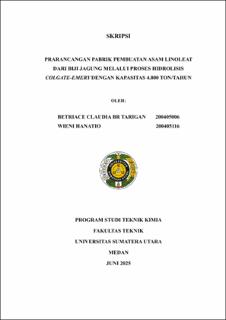| dc.description.abstract | The demand for linoleic acid in Indonesia, as an essential fatty acid, continues to
increase each year, as reflected in the rising import volumes. Therefore, boosting
domestic production is crucial to reduce dependence on imports and to support
national economic growth. Corn oil is a promising raw material due to its high
linoleic acid content, which can reach up to 60% by weight of total fatty acids.
Moreover, the underutilization of corn in Indonesia has led to economic losses for
farmers, making corn a suitable choice as a feedstock for linoleic acid production.
This preliminary plant design proposes the production of linoleic acid from corn
kernels via Colgate-Emery hydrolysis process, with a production capacity of 4,800
tons per year and an operating period of 330 days annually. The main processes
include corn oil extraction, oil degumming, oil hydrolysis with water, and fatty acid
crystallization. The plant is planned to be located in Serba Jadi District, Serdang
Bedagai Regency, North Sumatra, covering a land area of 21,717 m². The business
will operate as a limited liability company (PT) with a line-and-staff organizational
structure employing 171 workers. The total investment required is estimated at IDR
377,336,481,249, with annual production costs of IDR 351,917,994,155. Based on
the feasibility analysis, the project yields a Profit Margin of 32.2%, a Break-Even
Point (BEP) of 32.4%, a Return on Investment (ROI) of 35.5%, a Pay Out Time
(POT) of 2.82 years, a Return on Net Worth (RON) of 59.2%, and an Internal Rate
of Return (IRR) of 37.8%. These indicators suggest that the proposed linoleic acid
plant is economically feasible and viable for development. | en_US |


